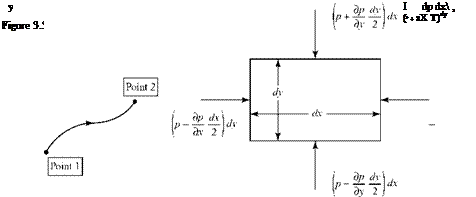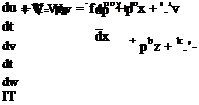Acceleration of a Fluid Particle: The Total Derivative
It is instructive to analyze the dynamics of fluid motion by means of differential elements rather than the somewhat mechanical procedure of converting the finite
 |
control-volume formulation into differential form. By this means, we can gain a deeper understanding of important features of the differential equations displayed in Table 3.6. We do this analysis in this subsection for the case of a two-dimensional flow in a rectangular coordinate grid to illustrate the procedure.
The Conservation of Momentum Principle is now applied to an infinitesimal system moving with the flow (i. e., to a fluid particle). For simplicity, the following derivation assumes an inviscid flow with negligible body-force effects. Details of the derivation are carried out in a two-dimensional Cartesian coordinate system for simplicity. The first step is to define a special way to look at the time derivative in a moving fluid, the so-called Eulerian, total, substantial, or substantive derivative. All of these terms are used interchangeably throughout the literature of fluid mechanics.
We illustrate the ideas by considering the time rate of change of the velocity (i. e., the acceleration) of a moving fluid particle. This special time rate of change is composed of the following two parts:
• unsteady acceleration: the rate of change due to changing conditions at a reference point in the field.
• convective acceleration: the rate of change due to the motion of the particle as it passes through the reference point
To illustrate these two different types of accelerations, imagine we are observers – moving with a fluid particle, as illustrated in Fig. 3.3.
Suppose that we reach a certain location (i. e., Point 1 in Fig. 3.3) in the flow at a certain time and at that same instant, the particle velocity changes because the flow is unsteady (i. e., the flow properties depend on time). This change in velocity represents acceleration of the particle. Now, what happens if the flow velocity is independent of time at a particular point? That is, any particle passing through that point always has the same velocity. Because the flow field is not necessarily uniform, then as the particle moves from Point 1 to Point 2, the moving observer notes that the velocity at Point 2 may be different from that experienced at Point 1 and that
this change in velocity has occurred over the transit time from Point 1 to Point 2. This corresponds to a change in velocity with respect to time (i. e., an apparent acceleration) due to the motion (i. e., convection) of the particle through the flow—hence, the descriptive term convective acceleration introduced in the previous subsection. The total time rate of change of velocity of a fluid particle traveling through an unsteady flow field then consists of two parts: the local acceleration and the convective acceleration. This combination often is referred to as the total derivative; other terminology also is used. With these physical ideas in mind, define:
DV
Eulerian derivative = total derivative = substantial derivative =——–
Dt
This notation represents the sum of both the unsteady (local) and the convective acceleration terms.
Recall that the velocity vector is a field property; it can be represented by a mathematical function of the spatial coordinates and time. That is, in general, the velocity vector can be written as V = V(x, y,z, t). For the two-dimensional case considered here, we write V = V(x, y,t). Then, if two points, Point 1 and Point 2, are differential distance Ar = Axi + Ayj apart in the x-y plane and At apart in time, we can write:
DV = lim J V(x + Ax, y + Ay, t + At)-V(x, y,t)l
Dt Atm0J At J
Use a Taylor series expansion to represent the first term in brackets. Notice that the partial derivatives of V in all three coordinate directions and time are required:
![]() , dV . dV dV A
, dV . dV dV A
![]() V (x, y, t) + —— Ax + —— Ay + —— At + dx dy dt
V (x, y, t) + —— Ax + —— Ay + —— At + dx dy dt
d2V (Ax)2
+ —–——+…
dx2 2 у
In the limit of a small time increment, the terms involving the squares (and higher) of the differential displacements become negligible. Then, passing to the limit as At ^ 0 gives:
DV = dV dx + dV dy +dV dy Dt dx dt dy dt dt dt’
Now, dx/dt = u because dx is the distance that the particle travels in the x-direction over the time interval dt. That is, dx is the x-projection of the infinitesimal distance between Point 1 and Point 2 that the particle traveled. Similarly, dy/dt = v. Thus, in this two-dimensional example:
DV _dV dV dV
Dt dt dx dy
In vector form, this equation may be written in shorthand notation as follows:
Notice that this is precisely the representation for the rate of change of the velocity vector deduced in Eq. 3.66. Again, for emphasis, the first term represents the local acceleration and the second term is the convective acceleration. It must be emphasized that the convective acceleration can be expressed in component form by direct substitution of the velocity vector in Eq. 3.72 only if rectangular coordinates are used. Thus, it is better to write:
which is valid for any curvilinear coordinate system.
It is now useful to use these ideas to check our derivation of the momentum equation. As before, the conservation of Momentum Principle can be expressed as Newton’s Second Law (i. e., sum of forces, ^f = time rate of change of momentum, pV) applied to a fluid particle (i. e., a system). Thus, the net force acting on the particle (due to pressure only, by assumption) is equal to the product of the mass of the particle (a constant) and the acceleration of the particle—that is, the product of the mass of the particle and the time rate of change of the particle velocity.
The net pressure force on the particle may be derived by taking a snapshot of the moving particle at an instant of time. At the time the picture is taken, the particle is assumed to be a cube (i. e., mathematically convenient; no loss of generality). Considering a two-dimensional Cartesian coordinate system, the cube appears as a square and the pressure force is pA, where the area is the length of a side times unity out of the page and the pressure acts perpendicular to all four sides. This is shown in Fig. 3.3(b).
The pressure is arbitrarily assumed to have the reference value p at the center of the particle—that is, at the point to which the element shrinks in the limit of a small mass element. With the positive coordinate directions assumed to be the positive force directions, the net pressure force, F, on the fluid particle is given by:
If there are no body forces or viscous forces, then, according to the Newton’s Second Law:
D DV DV
F = – (mt) = m— – ртМуНП—,
where the total acceleration can be represented by the total derivative, Eq. 3.72. Assembling all of the terms that enter into the momentum change/force balance,
F = P(dxdy)D,
it follows (for rectangular coordinates in two dimensions) that:
Эр. Эр. DV dV dV dV
-dx1 – dyJ=pD=P! T+pu aX+pv~dy •
Now, recall that V = ui + vj and write the two-component equations that follow from this vector equation; namely:
This is the momentum balance for a two-dimensional, inviscid, unsteady flow with no body forces written in Cartesian coordinate form. Compare Eq. 3.74 with Eq. 3.70, which originated in the statement of momentum conservation for a fixed control volume. Because steady flow was assumed in Eq. 3.70, the time derivative terms are not present. It is clear, however, that the two methods of analysis yield identical results, as they must. Thus, starting with either a fixed control volume or an infinitesimal fluid particle, the derivation of the differential equation expressing conservation of momentum leads to the same result. Note that although we illustrated the procedure in two dimensions, it is extended readily to three. The student is invited to repeat these steps for a three-dimensional element to verify that the method leads to the correct three-dimensional result (e. g., Eq. 3.69).
The other governing equations can be derived similarly. The differential – element technique is sometimes used to deduce the equations of motion in other than Cartesian coordinates by defining the appropriate infinitesimal element in terms of that coordinate system. For example, Fig. 3.4 shows an element that is appropriate for a three-dimensional cylindrical coordinate system. If the same procedure used to determine the Cartesian momentum balance of Eq. 3.73 were used with this element, the equivalent of Eq. 3.71 would be found. The details are left for the student in an exercise at the end of the chapter. This method is more lengthy than the one used previously; that is, by direct use of the vector operations appropriate to the coordinate system. However, it has the advantage of being more geometrically motivated and intuitive than the direct evaluation of the general vector expressions (e. g., Eq. 3.73) in dealing with other coordinate systems.























 y
y








